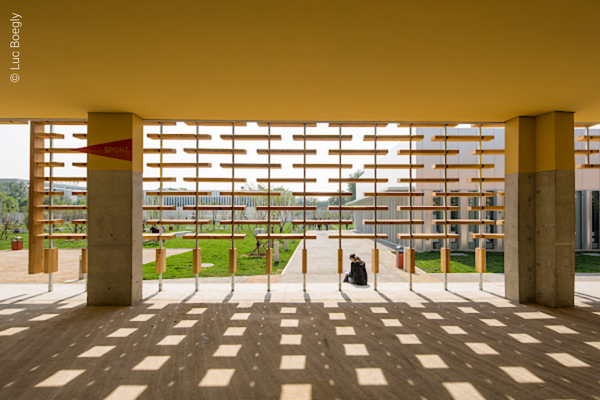School under (re)construction: a tutorial on learning environments

Learn about learning environments
Learning environments are changing simply because spaces designed several decades ago no longer reflect students’ needs. UNESCO’s publication The Futures of Learning 3 (2015) explains how modern pedagogical approaches such as flipped learning, collaborative learning, project-based learning or scenario-based problem-solving have necessitated changes in the layout of the classroom to allow movement and flexibility.
Image: Future Classroom Lab, European Schoolnet
The KeyCoNet project (2014) also recommended teaching key competences through interactive learning environments in which learners do practical tasks. While interactive learning environments encourage learners to be active and autonomous, they also require collaboration between them, so they may develop social and communicative competences.
Meanwhile, a study by the University of Salford, UK (2015) found that up to 16% of primary students’ learning progress in a single year could be attributed to well-designed classrooms. Natural light, temperature, air quality, colour and individualised classroom design were among the biggest physical factors impacting students’ learning progress.
Image: Simone Veil group of schools in Colombes, Dominique Coulon & associés (Photo: Eugeni Pons)
OECD’s Compendium of Exemplary Educational Facilities highlights outstanding cases of educational facility design from around the globe to inspire and inform decision-makers, educators and architects. One of the top six schools in the 2011 Compendium was Bertha von Suttner Schule in Schwechat, a school dedicated to children with a range of physical disabilities and psychological and behavioural disorders.
Ignite learning with a new approach
Activity bump: Why should movement be the prerogative of Physical Education? Take some inspiration from the iMO-LEARN cube or Ørestad Gymnasium’s staircase and make movement part of students’ daily life!
More books, different books:School libraries are far from obsolete, but with current technological advances, they should be digital as well as analogue. Also, librarians should embrace popular reading material like fantasy series, comic books or magazines. Children spend less time reading for enjoyment than they used to, especially boys, which is a great blow to their reading comprehension, according to PISA 2012; easy and appealing texts might serve as scaffolding to more complex works.
Image: Lishin Elementary School Library, TALI DESIGN
Whole-school technology: Electronic devices shouldn’t be the sole prerogative of the computer lab. If price is an issue, schools may consider purchasing computers decommissioned from corporations or large institutions, or borrowing tablets from a public library. A shortage of electrical outlets can also be rectified with surge-protected power strips. Creativity is born from limitation!
Success stories: The publication on Exploring and Adapting Learning Spaces in Schools includes concrete examples of school and classroom transformations in eight case studies from schools across Europe. One of the school leaders advises: “Set up a work group in school, develop a clear idea of what you are able to do, take a project approach to the development of the space, share your ideas with parents and the municipality to ensure their support and involvement.”
Put your finger on the school’s pulse
There is no one way or model to modernise schools’ learning environments. Here are some suggestions:
Get creative with furniture: Even the simple act of rearranging existing furniture breaks the traditional paradigm of rows and can transform interaction in the classroom. Think of a V-shape with rows of desks at right angles, facilitating communication between students; a horseshoe shape, allowing the teacher to talk to students from up close; a club layout, a conference table, a circle, and more. If possible, try to procure desks that can easily be moved around, and experiment!
Self-assess your learning spaces: Several projects have produced audit tools or checklists that might provide a useful starting point. One of them is OECD’s School User Survey: Improving Learning Spaces Together, which consists of three self-assessment questionnaires designed for students, teachers and school leaders. Survey results can be used at the school level to support continuous improvement and the intelligent use or refurbishment of educational facilities.
Image: Fênix, Arquitetura Nacional (Photo: Marcelo Donadussi)
Crowdsource your renovations: Students can be valuable participants in the redesign of their learning spaces; after all, they spend the most time in them. For example, the school head could organise a research walk, during which they or an architect would visit each space, talk to its users and catalogue their needs. For students, even smaller contributions like painting the school walls or choosing a playful tile pattern – like chessboard squares or tic-tac-toe – could make a big difference. Besides, a feeling of ownership can make them more mindful of school property.
Further reading:
- EDUSPACES guidebooks
- Guidelines on Exploring and Adapting Learning Spaces in Schools, European Schoolnet, 2017




